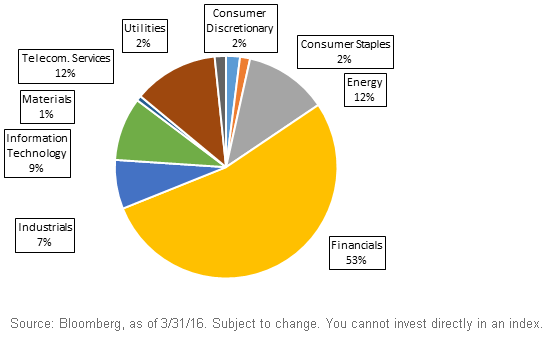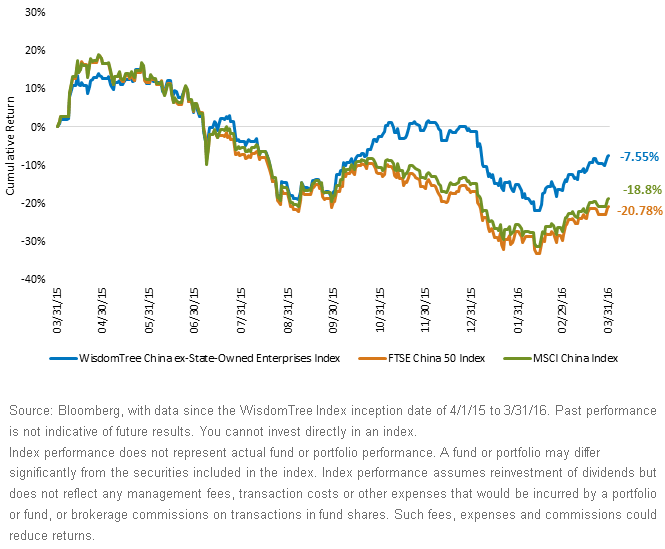Old China vs. New China


 WisdomTree believes these old-style indexes are not at all positioned to capitalize on China’s economic rebalancing initiatives.
The growth in China’s economy is better represented by a consumer-oriented or service-led economy. Those are companies in the technology sector (such as Alibaba, JD.com and Tencent), automakers (Great Wall Motors) or travel and tourism companies (Ctrip.com).4
The WisdomTree China ex-State-Owned Enterprises Index was designed with this theme in mind.
Removing the traditional state-run companies5 leaves a very different sector profile of the Chinese markets. Technology and consumer sectors dominate (making up almost two-thirds of exposure), compared to the traditional index focus on large banks and energy companies.
New Economy: WisdomTree China Ex-State-Owned Enterprises Index
WisdomTree believes these old-style indexes are not at all positioned to capitalize on China’s economic rebalancing initiatives.
The growth in China’s economy is better represented by a consumer-oriented or service-led economy. Those are companies in the technology sector (such as Alibaba, JD.com and Tencent), automakers (Great Wall Motors) or travel and tourism companies (Ctrip.com).4
The WisdomTree China ex-State-Owned Enterprises Index was designed with this theme in mind.
Removing the traditional state-run companies5 leaves a very different sector profile of the Chinese markets. Technology and consumer sectors dominate (making up almost two-thirds of exposure), compared to the traditional index focus on large banks and energy companies.
New Economy: WisdomTree China Ex-State-Owned Enterprises Index
 Since the inception of this Index, now just about hitting its one-year-live anniversary, the relative performance difference versus the major China indexes has been rather large. Click here for the standardized performance of the WisdomTree China ex-State-Owned Enterprises Index.
Differentiated Performance in a Challenging Market for China’s Equities
Since the inception of this Index, now just about hitting its one-year-live anniversary, the relative performance difference versus the major China indexes has been rather large. Click here for the standardized performance of the WisdomTree China ex-State-Owned Enterprises Index.
Differentiated Performance in a Challenging Market for China’s Equities
 Reallocating to China
China has been a source of global concern, but we believe much of the anxiety over the currency devaluation is misplaced. If you share our view that China will remain committed to growing its consumer-driven economy, we believe the WisdomTree China ex-State-Owned Enterprises Fund, CXSE, which is designed to track the performance of the WisdomTree China ex-State-Owned Enterprises Index discussed above, could be one of the best positioned vehicles for rebalancing the Chinese economy away from infrastructure and toward consumption and services.
On a tactical basis, one argument for repositioning now is that many investors in legacy China positions are likely facing a loss—with the sell-off in China over recent years. The time could be ripe for tax-loss harvesting out of those older positions into a strategy that is better positioned to reflect China’s economic growth goals going forward.
1Source: Howard Schneider and Lindsay Dunsmuir, “Yellen: Fed Not Likely to Reverse Course on Rates Despite Risks,” Reuters, 2/11/16.
2Source: Andy Rothman, “What to Trust? Measuring the Chinese Economy,” Sinology, 3/8/16.
3Traditional index: Refers to the FTSE China 50 Index universe, as of 3/31/16.
4For current holdings of the WisdomTree China ex-State-Owned Enterprises Index. For current holdings of the WisdomTree China ex-State-Owned Enterprises Fund.
5State-owned enterprises: Government ownership of more than 20% of outstanding shares of companies.
Reallocating to China
China has been a source of global concern, but we believe much of the anxiety over the currency devaluation is misplaced. If you share our view that China will remain committed to growing its consumer-driven economy, we believe the WisdomTree China ex-State-Owned Enterprises Fund, CXSE, which is designed to track the performance of the WisdomTree China ex-State-Owned Enterprises Index discussed above, could be one of the best positioned vehicles for rebalancing the Chinese economy away from infrastructure and toward consumption and services.
On a tactical basis, one argument for repositioning now is that many investors in legacy China positions are likely facing a loss—with the sell-off in China over recent years. The time could be ripe for tax-loss harvesting out of those older positions into a strategy that is better positioned to reflect China’s economic growth goals going forward.
1Source: Howard Schneider and Lindsay Dunsmuir, “Yellen: Fed Not Likely to Reverse Course on Rates Despite Risks,” Reuters, 2/11/16.
2Source: Andy Rothman, “What to Trust? Measuring the Chinese Economy,” Sinology, 3/8/16.
3Traditional index: Refers to the FTSE China 50 Index universe, as of 3/31/16.
4For current holdings of the WisdomTree China ex-State-Owned Enterprises Index. For current holdings of the WisdomTree China ex-State-Owned Enterprises Fund.
5State-owned enterprises: Government ownership of more than 20% of outstanding shares of companies. Important Risks Related to this Article
There are risks associated with investing, including possible loss of principal. Foreign investing involves special risks, such as risk of loss from currency fluctuation or political or economic uncertainty. The Fund focuses its investments in China, thereby increasing the impact of events and developments associated with the region, which can adversely affect performance. Investments in emerging or offshore markets are generally less liquid and less efficient than investments in developed markets and are subject to additional risks, such as risks of adverse governmental regulation and intervention or political developments. The Fund’s exposure to certain sectors may increase its vulnerability to any single economic or regulatory development related to such sectors.
As this Fund can have a high concentration in some issuers, the Fund can be adversely impacted by changes affecting those issuers. Please read the Fund’s prospectus for specific details regarding the Fund’s risk profile.

Jeremy Schwartz has served as our Global Chief Investment Officer since November 2021 and leads WisdomTree’s investment strategy team in the construction of WisdomTree’s equity Indexes, quantitative active strategies and multi-asset Model Portfolios. Jeremy joined WisdomTree in May 2005 as a Senior Analyst, adding Deputy Director of Research to his responsibilities in February 2007. He served as Director of Research from October 2008 to October 2018 and as Global Head of Research from November 2018 to November 2021. Before joining WisdomTree, he was a head research assistant for Professor Jeremy Siegel and, in 2022, became his co-author on the sixth edition of the book Stocks for the Long Run. Jeremy is also co-author of the Financial Analysts Journal paper “What Happened to the Original Stocks in the S&P 500?” He received his B.S. in economics from The Wharton School of the University of Pennsylvania and hosts the Wharton Business Radio program Behind the Markets on SiriusXM 132. Jeremy is a member of the CFA Society of Philadelphia.

